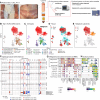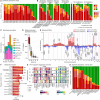Divergent Evolution of Malignant Subclones Maintains a Balance between Induced Aggressiveness and Intrinsic Drug Resistance in T-cell Cancer
- PMID: 40516109
- PMCID: PMC12498100
- DOI: 10.1158/2159-8290.CD-24-1856
Divergent Evolution of Malignant Subclones Maintains a Balance between Induced Aggressiveness and Intrinsic Drug Resistance in T-cell Cancer
Abstract
Evolution and outgrowth of drug-resistant cancer cells are common causes of treatment failure. Patients with leukemic cutaneous T-cell lymphoma have a poor prognosis because of the development of drug resistance and severe bacterial infections. In this study, we show that most patients with leukemic cutaneous T-cell lymphoma harbor multiple genetically distinct subclones that express an identical clonal antigen receptor but display distinct phenotypes and functional properties. These coexisting malignant subclones exhibit differences in tissue homing, metabolism, and cytokine expression and respond differently to extrinsic factors like Staphylococcus aureus and cancer drugs. Indeed, although S. aureus toxins selectively enhance activation and proliferation of certain subclones, these responsive subclones are also the most intrinsically sensitive to cancer drugs when the stimuli are removed. Consequently, although the divergent evolution of malignant subclones drives aggressiveness, adaptability, and drug resistance by removing extrinsic stimuli and mapping malignant subclones, we can expose inherent vulnerabilities that can be exploited in the treatment of these cancers.
Significance: Cancer cells have inherent disparity in hallmark traits, such as aggressiveness and intrinsic drug resistance. We show that segregation of hallmark traits on different coexisting subclones is common and augments adaptability, aggressiveness, and drug resistance of the overall cancer population. Importantly, this segregation exposes vulnerabilities that can be exploited in individualized therapies.
©2025 The Authors; Published by the American Association for Cancer Research.
Conflict of interest statement
T.B. Buus reports grants from LEO Foundation and Danish Cancer Society during the conduct of the study; personal fees from Novo Nordisk A/S outside the submitted work; and a patent for Treatment of Lymphoma (WO2025/093666) issued. C.K. Vadivel reports grants from Danish Cancer Society (Kræftens Bekæmpelse, R350-A20095 and R389-A23017) and Knæk Cancer (Fight Cancer) during the conduct of the study, as well as a patent for Treatment of Lymphoma (WO2025/093666) issued. L. Yan reports grants from Danish Cancer Society outside the submitted work. M.H. Andersen reports grants, personal fees, and nonfinancial support from IO Biotech and personal fees from Astellas Pharma outside the submitted work. M. Wobser reports personal fees from Takeda, Kyowa Kirin, and Recordati Rare Diseases outside the submitted work. J.C. Becker reports personal fees and other support from ICON during the conduct of the study, as well as grants, personal fees, and nonfinancial support from Merck Serono, personal fees from Regeneron, Incyte, Sun Pharma, and Amgen, and grants from Alcedis outside the submitted work. R. Bech reports grants from Kyowa Kirin and personal fees from Recordati outside the submitted work. N. Ødum reports grants from The Danish Cancer Society, The Danish Research Fund, and The Novo Nordic Foundation and nonfinancial support from Micreos Pharmaceutical during the conduct of the study; and a patent for Treatment of Lymphoma (WO2025/093666) issued. No disclosures were reported by the other authors.
Figures







References
-
- Turner NC, Reis-Filho JS. Genetic heterogeneity and cancer drug resistance. Lancet Oncol 2012;13:e178–85. - PubMed
-
- Latzka J, Assaf C, Bagot M, Cozzio A, Dummer R, Guenova E, et al. EORTC consensus recommendations for the treatment of mycosis fungoides/Sézary syndrome - update 2023. Eur J Cancer 2023;195:113343. - PubMed
-
- Agar NS, Wedgeworth E, Crichton S, Mitchell TJ, Cox M, Ferreira S, et al. Survival outcomes and prognostic factors in mycosis fungoides/sézary syndrome: validation of the revised International Society for Cutaneous Lymphomas/European Organisation for Research and Treatment of Cancer staging proposal. J Clin Oncol 2010;28:4730–9. - PubMed
MeSH terms
Grants and funding
LinkOut - more resources
Full Text Sources

